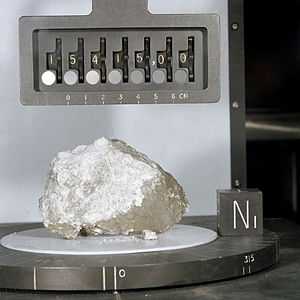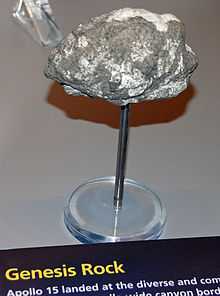Genesis Rock

The Genesis Rock is a sample of Moon rock retrieved by Apollo 15 astronauts James Irwin and David Scott in 1971 during their second lunar EVA. It is currently stored at the Lunar Sample Laboratory Facility in Houston, Texas.
Chemical analysis of the Genesis Rock indicated it is an anorthosite, composed mostly of a type of plagioclase feldspar known as anorthite. The rock was formed in the early stages of the solar system, at least 4 billion years ago.[1] It was recovered in a crater of the Moon, near other rocks of its kind.
It was originally thought they had found a piece of the Moon's primordial crust, but later analysis initially showed that the rock was only 4.1 ± 0.1 billion years old, which is younger than the Moon itself; and was formed after the Moon's crust solidified. But it was still an extremely old sample, and was from the Pre-Nectarian. Dating of pyroxenes from other anorthosite samples gave a samarium-neodymium age of crystallization of 4.46 billion years.[2]
The solar system was formed only around 100 million years earlier.[3]
See also

- Apollo 15 on the Moon
- Hadley–Apennine (Moon)
- Anorthosite
References
- ↑ Apollo 15 samples overview Lunar and Planetary Institute
- ↑ Norman, M. D., Borg, L. E., Nyquist, L. E., and Bogard, D. D. (2003) Chronology, geochemistry, and petrology of a ferroan noritic anorthosite clast from Descartes breccia 67215: Clues to the age, origin, structure, and impact history of the lunar crust, Meteoritics and Planetary Science, vol 38, p. 645-661 Summary
- ↑ Chaikin, A., and T. Hanks. 1998. A man on the Moon : the voyages of the Apollo astronauts. Penguin Books, New York, N.Y.
External links
- Lunar and Planetary Institute - Apollo 15
- NASA - Apollo 15
- Discovering the Genesis Rock (From the Apollo Lunar Surface Journal, scroll down to 145:41:48.)
- Astronaut Scott examines the Genesis rock. (image)
- An overview of the samples collected by Apollo 15. (The Genesis Rock is sample #15415 and is described but not listed by its number.)
- 15414 sample description (Lunar and Planetary Institute)